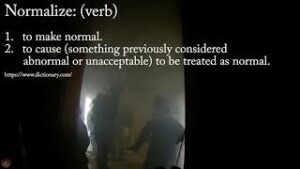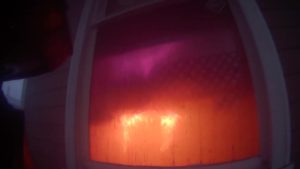As many people have noted, the largest changes in fire behavior come at compartment breaks. The header between one room and the next forces heat and fire gasses to accumulate in one room for a time before they can break out into the next. This means that conditions can be different from room to room even when doors are left open. Visibility can be adequate in one room and almost zero in another. Heat and fire conditions can be very survivable in one room and intense in the next. As we proceed forward, either as the hose team or the search crew, we need to pause at our compartment breaks to reassess conditions and evaluate the new space.
This change from compartment to compartment is demonstrated clearly in this training burn. In the entry room, the conditions are fairly clear and heat levels are low. In the kitchen, there is rollover in the smoke layer all the way to the header dividing the two rooms. The rollover in the kitchen can’t be seen until the firefighters actually enter the room. This also demonstrates the importance of cooling the header with the hose stream when entering a room that has been on fire. The header of the entry doorway takes more heat than almost any other area of the involved room and can’t be cooled by the stream until entry has been made to the fire room. Once the nozzle enters the room, if they feel substantial heat on the back of their head and neck as they move forward the header should be cooled.
The ability to pause at compartment breaks requires that we remain calm and collected rather than charging through the building in an undisciplined search for the fire. Failure to take the necessary time at a new compartment can lead to getting deep into a superheated area and expose the team to unnecessary punishment.



